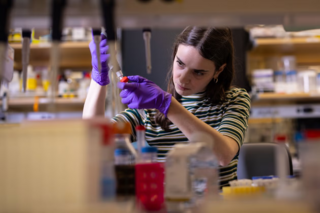Isaacs Lab expands the reach and precision of human gene editing

Anabel Schweitzer, a student in Yale’s Graduate School of Arts and Sciences and a member of Isaacs’ lab. Photo by Dan Renzetti
A new study published by the Isaacs lab has greatly improved the ability to edit multiple DNA sites without creating unwanted mutations. The team, led by MCDB graduate student Anabel Schweitzer, fused Cas9 and Cas12 to an enzyme to make targeted chemical changes to DNA. This new system, guided by engineered gRNAs, successfully altered gene sequences at 15 different sites in human cells with greater precision. The success of this system has great implications for understanding the root cause of genetic disease as well as the creation of medications.
Yale News goes more in-depth with Anabel Schweitzer and Farren Isaacs.